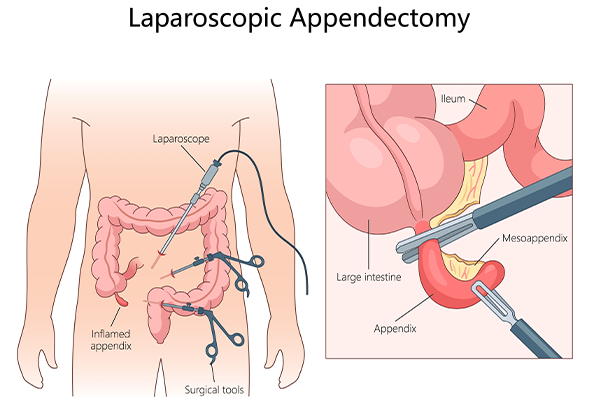
People of all ages are susceptible to appendicitis, one of the most frequent surgical emergencies. Timely diagnosis and removal of this medical condition are essential to prevent complications such as rupture or infection when the appendix becomes inflamed. Thankfully, a laparoscopic appendectomy provides a quick, safe, and efficient solution with less scarring and a quicker recovery, thanks to developments in minimally invasive surgery.
The definition of laparoscopic appendectomy, its advantages, its technique, and what patients can anticipate prior to, during, and following the procedure are covered in this blog. Scroll till the end to gather the medically accurate information regarding all the aspects related to it.
Synopsis
What Is Appendicitis?
-
The inflammation of the appendix, a tiny pouch that resembles a finger and is connected to the large intestine, is known as appendicitis.
-
The inflammation can be a result of blockage due to foreign bodies, tumours, hard stool, and infections in the gastrointestinal tract.
-
An inflamed appendix may rupture if treatment is not received, which could result in dangerous side effects like abscess formation or peritonitis (infection of the abdominal lining).

Common Symptoms of Appendicitis
-
Sudden pain in the lower right abdomen
-
Nausea or vomiting
-
Fever
-
Abdominal bloating
-
Pain that worsens with movement, coughing, or deep breathing
What Is a Laparoscopic Appendectomy?
The inflamed appendix can be removed with a minimally invasive procedure called a laparoscopic appendectomy. In contrast to open surgery, which necessitates a wider incision, laparoscopic surgery uses:
-
Three or four tiny cuts
-
A laparoscope is a camera-equipped thin tube
-
Specialised tools to carry out the abdominal surgery
With minimal harm to the surrounding tissues, the surgeon carefully removes the appendix while viewing the inside of the abdomen on a monitor.
Benefits of Laparoscopic Appendectomy
Laparoscopic surgeries have been in the news since their invention due to their various benefits, and the foremost amongst them is minimal incisions, faster recoveries, shorter hospital stays and more. Let’s look at all these benefits in great detail below and how laparoscopic surgeries have redefined appendectomy:
-
Reduced Incision Size - Results in less obvious scarring and less pain after surgery.
-
Quicker Recuperation - Within 24 to 48 hours, the majority of patients return home, and within 1-2 weeks, they resume their regular activities.
-
Reduced Infection Risk - Smaller wounds heal more quickly and expose fewer bacteria.
-
Reduced Blood Loss - Abdominal structures are preserved because the minimally invasive technique results in less tissue damage.
-
Better for Patients Who Are Overweight - For patients with higher BMI, laparoscopy improves visibility and accessibility, leading to better results.
Who Is a Candidate for Laparoscopic Appendectomy?
The majority of patients with simple appendicitis are suitable candidates. Open surgery may still be an option, though, in specific circumstances, such as an appendix rupture, an abscess, or prior abdominal surgeries.
The best course of action will be decided by your surgeon based on the analysis of the following parameters:
-
Health history
-
Infection severity
-
When symptoms first appeared
-
Imaging reports (CT scan or ultrasound)
How the Procedure Works: Step-by-Step
1. Getting Ready for Surgery
-
It is recommended that you fast for six to eight hours prior to surgery.
-
The purpose of antibiotics is to lower the risk of infection.
-
Basic lab tests and imaging will be performed on you.
2. The use of anaesthesia
-
Under general anaesthesia, the procedure is carried out.
3. A surgical operation
-
The abdomen is cut with tiny incisions.
-
One incision is used to insert a laparoscope.
-
The others are used to insert surgical instruments.
-
After careful dissection, the appendix is extracted.
-
Incisions are sealed with glue or sutures after the area has been cleaned.
4. Care Following Surgery
-
After surgery, you will be observed for a few hours.
-
Antibiotics and painkillers are prescribed.
-
Within a few hours, patients are typically able to walk and quickly return to a liquid diet.
Recovery and Aftercare
-
Within seven to ten days, most people resume their regular activities.
-
Avoid strenuous activities for two to four weeks.
-
Keep an eye out for symptoms of complications, such as fever, pus, or excruciating pain.
-
Follow-up appointments guarantee that the healing process is proceeding as planned.
Risks and Complications (Rare but Possible)
Laparoscopic appendectomy is generally very safe. Still, like any surgery, risks include:
-
Bleeding
-
Infection
-
Reaction to anaesthesia
-
Damage to nearby organs
-
Conversion to open surgery if complications arise
With experienced surgeons and modern facilities, these risks are minimal. You can rely on us for optimum care and facilities because we are committed to providing the best to our patients in every way possible.
Conclusion
A contemporary, efficient, and patient-friendly treatment for appendicitis is laparoscopic appendectomy. It is now the recommended method in the majority of cases due to its low pain, quick recovery, and superior safety. Do not hesitate to seek medical attention right away if you or a loved one is exhibiting signs of appendicitis. In addition to preventing complications, early intervention guarantees a quicker and more seamless recovery.
Even though your appendix is tiny, ignoring it can have serious consequences. Laparoscopic surgery has made it easier and safer than ever to return to life.





















 5 Min Read
5 Min Read




.png)




_Early_Detection.png)









